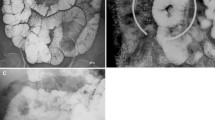Abstract
Patients with inflammatory bowel disease (IBD) may confront a variety of nonintestinal problems. The first North American population-based data describing the incidence rates of several of these disorders have been reported over the past year. Reports have also documented our expanding knowledge of peristomal pyoderma gangrenosum, and of ulcerative colitis following liver transplantation in patients with primary sclerosing cholangitis. Osteopenia continues to receive considerable attention. Factors such as osteoprotegrin ligand, and its interaction with receptor activator of nuclear factor kappa B, are connected with T-cell activity, inflammation, and osteoclastogenesis. Studies in these and other areas are addressed in this review.
Similar content being viewed by others
References and Recommended Reading
Bernstein CN, Blanchard JF, Rawsthorne P, Yu N: The prevalence of extraintestinal diseases in inflammatory bowel disease: a population-based study. Am J Gastroenterol 2001, 96:1116–1122. This is the first North American population-based study assessing the prevalence of PSC, ankylosing spondylitis, iritis, uveitis, pyoderma gangrenosum, and erythema nodosum in IBD.
Bernstein CN, Blanchard JF, Rawsthorne P, Wajda A: The epidemiology of Crohn’s disease and ulcerative colitis in a central Canadian province: a population-based study. Am J Epidemiol 1999, 149:916–924.
Tromm A, May D, Almus E, et al.: Cutaneous manifestations in inflammatory bowel disease. Z Gastroenterol 2001, 39:137–144.
Friedman S, Marion JF, Scherl E, et al.: Intravenous cyclosporine in refractory pyoderma gangrenosum complicating inflammatory bowel disease. Inflamm Bowel Dis 2001, 7:1–7.
Sheldon DG, Sawchuk LL, Kozarek RA, Thirlby RC: Twenty cases of peristomal pyoderma gangrenosum: diagnostic implications and management. Arch Surg 2000, 135:564–568.
Hughes AP, Jackson JM, Callen JP: Clinical features and treatment of peristomal pyoderma gangrenosum. JAMA 2000, 284:1546–1548.
Kelly P, Patchett S, McCloskey D, et al.: Sclerosing cholangitis, race and sex. Gut 1997, 41:688–689.
Terjung B, Herzog V, Worman HJ, et al.: Atypical antineutrophil cytoplasmic antibodies with perinuclear fluorescence in chronic inflammatory bowel diseases and hepatobiliary disorders colocalize with nuclear lamina proteins. Hepatology 1998, 28:332–340.
Terjung B, Spengler U, Sauerbach T, Worman HJ: ‘Atypical p-ANCA‘ in IBD and hepatobiliary disorders reacts with a 50-kilodalton nuclear envelope protein of neutrophils and myeloid cell lines. Gastroenterology 2000, 119:310–322. This study defines the myeloid nuclear antigen(s) to which pANCA in IBD binds.
Bergquist A, Glaumann H, Persson B, Broome U: Risk factors and clinical presentation of hepatobiliary carcinoma in patients with primary sclerosing cholangitis: a case control study. Hepatology 1998, 27:311–316.
Herzog K, Goldblum JR: Gall bladder adenocarcinoma, acalculous chronic lymphoplasmacytic cholecystitis, ulcerative colitis. Mod Pathol 1996, 9:194–198.
Rasmussen HH, Fallingborg JF, Mortensen PB, et al.: Hepatobiliary dysfunction and primary sclerosing cholangitis in patients with Crohn’s disease. Scand J Gastroenterol 1997, 32:604–610.
Heikius B, Niemela S, Lehtola J, et al.: Hepatobiliary and coexisting pancreatic duct abnormalities in patients with inflammatory bowel disease. Scand J Gastroenterol 1997, 32:153–161.
Heikius B, Niemela S, Lehtola S, Karttunen TJ: Elevated pancreatic enzymes in inflammatory bowel disease are associated with extensive disease. Am J Gastroenterol 1999, 94:1062–1079.
Papatheodoridis GV, Hamilton M, Mistry PK, et al.: Ulcerative colitis has an aggressive course after orthotopic liver transplantation for primary sclerosing cholangitis. Gut 1998, 43:639–644.
Schoon EJ, Muller MCA, Vermeer C, et al.: Low serum and bone vitamin K status in patients with longstanding Crohn’s disease: another pathogenetic factor of osteoporosis in Crohn’s disease? Gut 2001, 48:473–477.
Binkley NC, Suttie JW: Vitamin K nutrition and osteoporosis. J Nutr 1995, 125:1812–1821.
Carraballo PJ, Heit JA, Atkinson EJ, et al.: Long term use of oral anticoagulants and the risk of fracture. Arch Intern Med 1999; 159:1750–1756.
Kong Y-Y, Boyle WJ, Penninger JM: Osteoprotegrin ligand: a regulator of immune response and bone physiology. Immunol Today 2000, 21:495–502. This is a review of the biology of OPGL, a molecule that may be an important link between osteoclastogenesis (and hence osteoporosis) and T-cell biology (and hence systemic inflammation).
Bernstein CN: Risk factors and prevalence of bone disease in inflammatory bowel disease. In Trends in Inflammatory Bowel Disease Therapy, 1999. Edited by Williams CN, Bursey RF, Gall DG, et al. Dordrecht: Kluwer Academic Publishers; 1999:147–162.
Schoon EJ, van Nunen AB, Wouters RSME, et al.: Osteopenia and osteoporosis in Crohn’s disease: prevalence in a Dutch population-based cohort. Scand J Gastroenterol 2000, 35(suppl 232):43–47.
Schoon EJ, Blok BM, Geerling BJ, et al.: Bone mineral density in patients with recently diagnosed inflammatory bowel disease. Gastroenterology 2000, 119:1203–1208.
Vestergaard P, Krogh K, Rejnmark L, et al.: Fracture risk is increased in Crohn’s disease, but not in ulcerative colitis. Gut 2000, 46:176–181.
Bernstein CN, Blanchard JF, Leslie W, et al.: The incidence of fractures among patients with IBD: a population-based study. Ann Intern Med 2000, 133:795–799. This is the first population-based study reporting the incidence of fractures in patients with IBD. The incidence is quantified at approximately one fracture/100 patient-years. Compared with a matched cohort, there was a 40% increased risk of sustaining a fracture.
Haderslev KV, Tjellesen L, Sorensen HA, Staun M: Alendronate increases lumbar spine bone mineral density in patients with Crohn’s disease. Gastroenterology 2000, 119:639–646.
Schulte CMS, Dignass AU, Goebell H, et al.: Genetic factors determine extent of bone loss in inflammatory bowel disease. Gastroenterology 2000, 119:909–920. This interesting study attempted to correlate cytokine genotyping for proinflammatory cytokines with rate of annual bone loss.
Bernstein CN, Blanchard JF, Houston D, Wajda A: The incidence of venous thromboembolic disease among patients with IBD: a population-based study. Thromb Haemost 2001, 85:430–434. This is the first population-based study reporting the incidence of venous thromboembolism in patients with IBD. The incidence is quantified at approximately one venous thrombosis/200 patientyears. Compared with a matched cohort, there was a threefold to fourfold increased risk of sustaining DVT/PE.
Guedon C, Le Cam-Duchez V, Lalaude O, et al.: Prothrombotic inherited abnormalities other than factor V Leiden mutation do not play a role in venous thrombosis. Am J Gastroenterol 2001, 96:1448–1454.
Author information
Authors and Affiliations
Rights and permissions
About this article
Cite this article
Bernstein, C.N. Extraintestinal manifestations of inflammatory bowel disease. Curr Gastroenterol Rep 3, 477–483 (2001). https://doi.org/10.1007/s11894-001-0068-6
Issue Date:
DOI: https://doi.org/10.1007/s11894-001-0068-6




